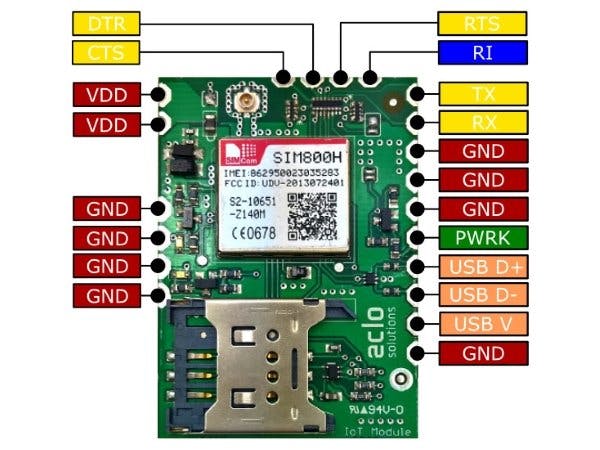Hardware components | ||||||
 |
| × | 1 | |||
Software apps and online services | ||||||
| ||||||
 |
| |||||
Using a GPRS module with AT commands can be a bit tricky, specially with the initializations and configurations. The nanoFramework driver "hides" all that from the developer allowing him to focus on the task at hand. In this sample we are sending sensor data to Thingspeak by calling their API through an HTTP post request.
For the code sample to work, you need to:
1. Replace the placeholder there with the details of your service provider APN details.
2. Sign up for a Thingspeak account here in order to authenticate the HTTP request.
using Eclo.nF.SIM800H;
using System;
using System.Text;
using System.Threading;
using Windows.Devices.Gpio;
using Windows.Devices.SerialCommunication;
namespace SIM800HSamples
{
public class Program
{
private const string APNConfigString = "<replace-with-apn-name>|<replace-with-apn-user>|<replace-with-apn-password>";
private const string thingsSpeakApiKey = "<replace-with-your-api-key>";
public static void Main()
{
InitializeSIM800H();
// loop forever and output available RAM each 5 seconds
while (true)
{
Thread.Sleep(5000);
// output signal RSSI
Console.WriteLine("Network signal strength is " + SIM800H.RetrieveSignalStrength().GetSignalStrengthDescription());
};
}
static void InitializeSIM800H()
{
// initialization of the module is very simple
// we just need to pass a serial port and an output signal to control the "power key" signal
// SIM800H serial device
SerialDevice sim800SerialDevice = SerialDevice.FromId("COM2");
// SIM800H signal for "power key"
GpioPin sim800PowerKey = GpioController.GetDefault().OpenPin(0 * 1 + 10, GpioSharingMode.Exclusive);
sim800PowerKey.SetDriveMode(GpioPinDriveMode.Output);
Console.WriteLine("... Configuring SIM800H ...");
// configure SIM800H device
SIM800H.Configure(sim800PowerKey, ref sim800SerialDevice);
// add event handler to be aware of network registration status changes
SIM800H.GsmNetworkRegistrationChanged += SIM800H_GsmNetworkRegistrationChanged;
// add event handler to be aware of GPRS network registration status changes
SIM800H.GprsNetworkRegistrationChanged += SIM800H_GprsNetworkRegistrationChanged;
// it's wise to set this event handler to get the warning conditions from the module in case of under-voltage, over temperature, etc.
SIM800H.WarningConditionTriggered += SIM800H_WarningConditionTriggered;
// because we need Internet connection the access point configuration (APN) is mandatory
// the configuration depends on what your network operator requires
// it may be just the access point name or it may require an user and password too
// AccessPointConfiguration class provides a number of convenient options to create a new APN configuration
SIM800H.AccessPointConfiguration = AccessPointConfiguration.Parse(APNConfigString);
// async call to power on module
// in this example we are setting up a callback on a separate method
SIM800H.PowerOnAsync(PowerOnCompleted);
Console.WriteLine("... Power on sequence started ...");
}
private static void PowerOnCompleted(IAsyncResult result)
{
// check result
if (((PowerOnAsyncResult)result).Result == PowerStatus.On)
{
Console.WriteLine("... Power on sequence completed...");
}
else
{
// something went wrong...
Console.WriteLine("### Power on sequence FAILED ###");
}
}
private static void SIM800H_GsmNetworkRegistrationChanged(NetworkRegistrationState networkState)
{
Console.WriteLine(networkState.GetDescription("GSM"));
}
private static void SIM800H_GprsNetworkRegistrationChanged(NetworkRegistrationState networkState)
{
Console.WriteLine(networkState.GetDescription("GPRS"));
if (networkState == NetworkRegistrationState.Registered)
{
// SIM800H is registered with GPRS network so we can request an Internet connection now
// add event handler to know when we have an active Internet connection
// remove it first so we don't have duplicate calls in case a new successful registration occurs
SIM800H.GprsProvider.GprsIpAppsBearerStateChanged -= GprsProvider_GprsIpAppsBearerStateChanged;
SIM800H.GprsProvider.GprsIpAppsBearerStateChanged += GprsProvider_GprsIpAppsBearerStateChanged;
// async call to GPRS provider to open the GPRS bearer
// we can set a callback here to get the result of that request and act accordingly
// or we can manage this in the GprsIpAppsBearerStateChanged event handler that we've already setup during the configuration
SIM800H.GprsProvider.OpenBearerAsync(BearerProfile.IpAppsBearer);
}
}
private static void GprsProvider_GprsIpAppsBearerStateChanged(bool isOpen)
{
if (isOpen)
{
// launch a new thread to download weather data
new Thread(() =>
{
Thread.Sleep(1000);
UploadDataToChannel();
}).Start();
}
}
private static void SIM800H_WarningConditionTriggered(WarningCondition warningCondition)
{
// get friendly string for this warning condition
Console.WriteLine(SamplesExtensions.GetWarningDescription(warningCondition));
}
static void UploadDataToChannel()
{
// download weather data for Lisbon (Portugal) from Open Weather Data
Console.WriteLine("... uploading data to channel ...");
/////////////////////////////////////////////////////
// option 1: using .NETMF API like and data on URL //
/////////////////////////////////////////////////////
byte[] receivedBody = new byte[500];
// data to upload to channel
double newData1 = 15.16;
double newData2 = 11.12;
/*
// create HTTTP web request with URI
using (var webRequest = (HttpWebRequest)WebRequest.Create(new Uri("http://api.thingspeak.com/update?key=" + thingsSpeakApiKey + "&headers=false&field1=" + newData1.ToString("N2") + "&field2 = " + newData2.ToString("N2"))))
{
// set HTTP method for the request
webRequest.Method = "POST";
// perform the request and get the response
using (var res = webRequest.GetResponse() as HttpWebResponse)
{
Console.WriteLine("******************************************************");
Console.WriteLine(res.BodyData);
Console.WriteLine("******************************************************");
}
}
// need to wait 15 seconds to send new data to the same channel (ThingSpeak usage policy)
Thread.Sleep(15000);
*/
///////////////////////////////////////////////////////////////////
// option 2: using the HTTP client of the driver and data on URL //
///////////////////////////////////////////////////////////////////
/*
newData1 = 18.19;
newData2 = 17.18;
using (var webRequest = (HttpWebRequest)WebRequest.Create(new Uri("http://api.thingspeak.com/update?key=" + thingsSpeakApiKey + "&headers=false&field1=" + newData1.ToString("N2") + "&field2 = " + newData2.ToString("N2"))))
{
// set HTTP method for the request
webRequest.Method = "POST";
// perform the HTTP request asynchronously and set a callback handler to print the response
SIM800H.HttpClient.PerformHttpWebRequestAsync(webRequest, true, false, true, 5000, (ar) =>
{
// get the response
var response = ((HttpWebRequestAsyncResult)ar).HttpResponse;
// check if the HTTP request was successful
if (response.RequestSuccessful)
{
Console.WriteLine("******************************************************");
// grab body data as a string directly from the response
Console.WriteLine(response.BodyData);
Console.WriteLine("******************************************************");
}
});
}
// need to wait 15 seconds to send new data to the same channel (ThingSpeak usage policy)
Thread.Sleep(15000);
*/
//////////////////////////////////////////////////////////////////////////////////////////////
// option 3: using the HTTP client of the driver, data in body and authentication in header //
//////////////////////////////////////////////////////////////////////////////////////////////
newData1 = 28.29;
newData2 = 18.19;
using (var webRequest = (HttpWebRequest)WebRequest.Create(new Uri("http://api.thingspeak.com/update?&headers=false")))
{
// set HTTP method for the request
webRequest.Method = "POST";
// send authentication in a header
// check ThingsSpeak API documentation
webRequest.Headers.Add("THINGSPEAKAPIKEY", thingsSpeakApiKey);
// request data that will be send on the request body
// there are two options to add request data
// 1) in a stream using webRequest.GetRequestStream() for .NETMF API like usage
// 2) as a string by setting the webRequest.Data field
// for this example we'll be using option 2) which is the most straightforward
webRequest.Data = "field1=" + newData1.ToString("N2");
webRequest.Data += "\r\n" + "&field2=" + newData2.ToString("N2");
// perform the HTTP request asynchronously and set a callback handler to print the response
SIM800H.HttpClient.PerformHttpWebRequestAsync(webRequest, true, false, true, 5000, (ar) =>
{
// get the response
var response = ((HttpWebRequestAsyncResult)ar).HttpResponse;
// check if the HTTP request was successful
if (response.RequestSuccessful)
{
Console.WriteLine("******************************************************");
// grab body data as a string directly from the response
Console.WriteLine(response.BodyData);
Console.WriteLine("******************************************************");
}
});
}
}
}
}
9 projects • 16 followers
Founder of Eclo Solutions, hardware, software and embedded system enthusiast. Co-founder of the nanoFramework project.









Comments